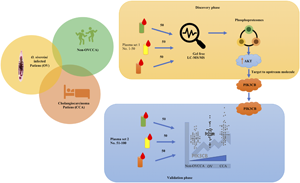Article contents
Phosphatidylinositol 4,5-bisphosphate 3-kinase catalytic subunit beta as a potential biomarker for Opisthorchis viverrini infection and cholangiocarcinoma
Published online by Cambridge University Press: 05 October 2021
Abstract

The human liver fluke Opisthorchis viverrini (Ov), the primary risk factor for cholangiocarcinoma (CHCA), is a parasite endemic to southeast Asian countries. With no effective treatments for CHCA currently available, early diagnosis and treatment of Ov infection remains the only practical method for the prevention of CHCA. In this study, plasma phosphoproteomes of patients in the non-Ov infection, non-cholangiocarcinoma subject group (non-OVCCA), the asymptomatic Ov infected group (OV), and the CHCA group (CCA), were investigated to identify potential biomarkers for Ov infection and CHCA. The AKT signalling pathway was found to be up-regulated. Phosphatidylinositol 4,5-bisphosphate 3-kinase catalytic subunit beta isoform (PIK3CB), an upstream signalling molecule, was selected as a potential biomarker and evaluated using indirect enzyme-linked immunosorbent assay (ELISA). Results demonstrated evidence that levels of PIK3CB in both the OV group and CCA group was statistically different compared to the non-OVCCA group (P < 0.01). However, the levels of PIK3CB between the OV group and the CCA group were found not to be statistically different. Sensitivity and specificity for OV using OD450 cut-off at >1.570 was 76 and 72%, respectively. For CCA, sensitivity and specificity using OD450 cut-off at >1.398 was 68 and 76%, respectively. Application of indirect ELISA detecting plasma PIK3CB will be of great benefit for screening of opisthorchiasis and CHCA.
Information
- Type
- Research Article
- Information
- Copyright
- Copyright © The Author(s), 2021. Published by Cambridge University Press
References
- 5
- Cited by


